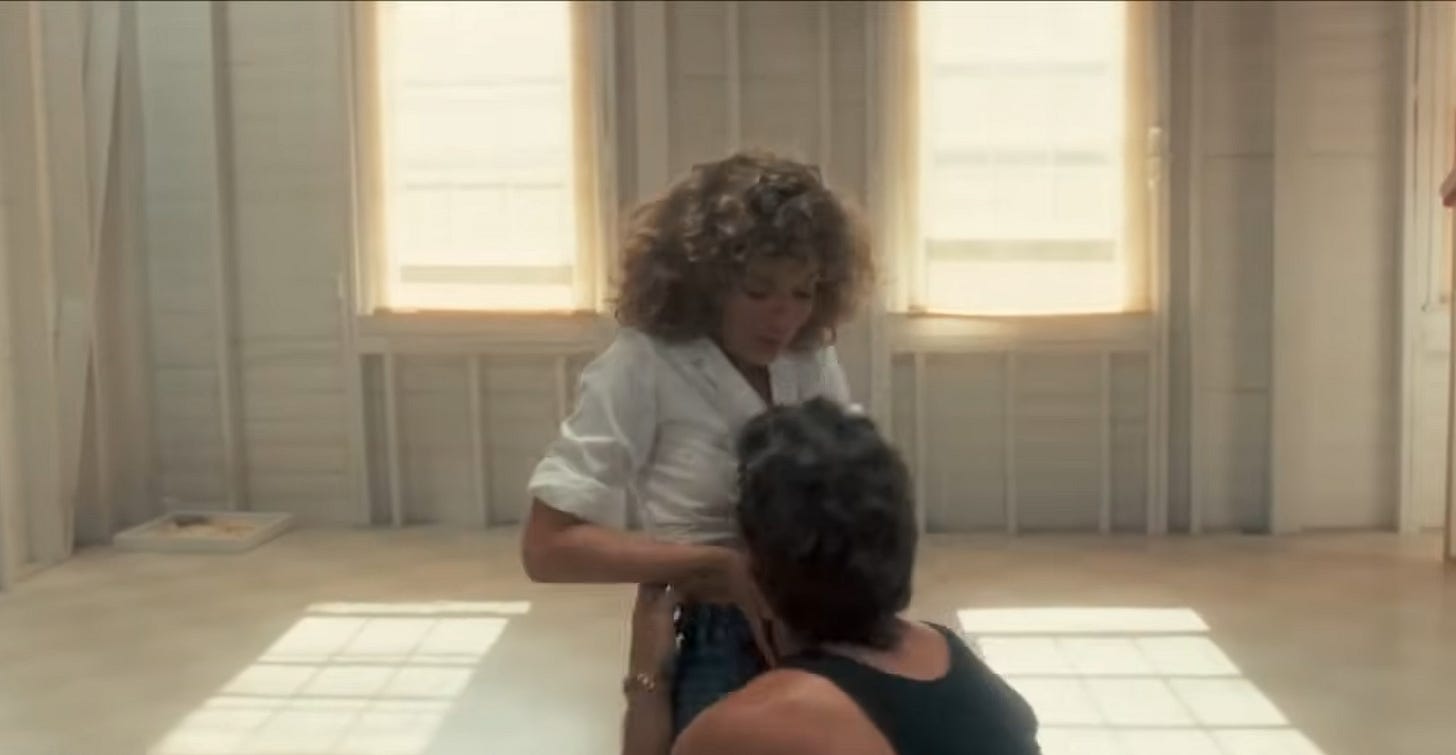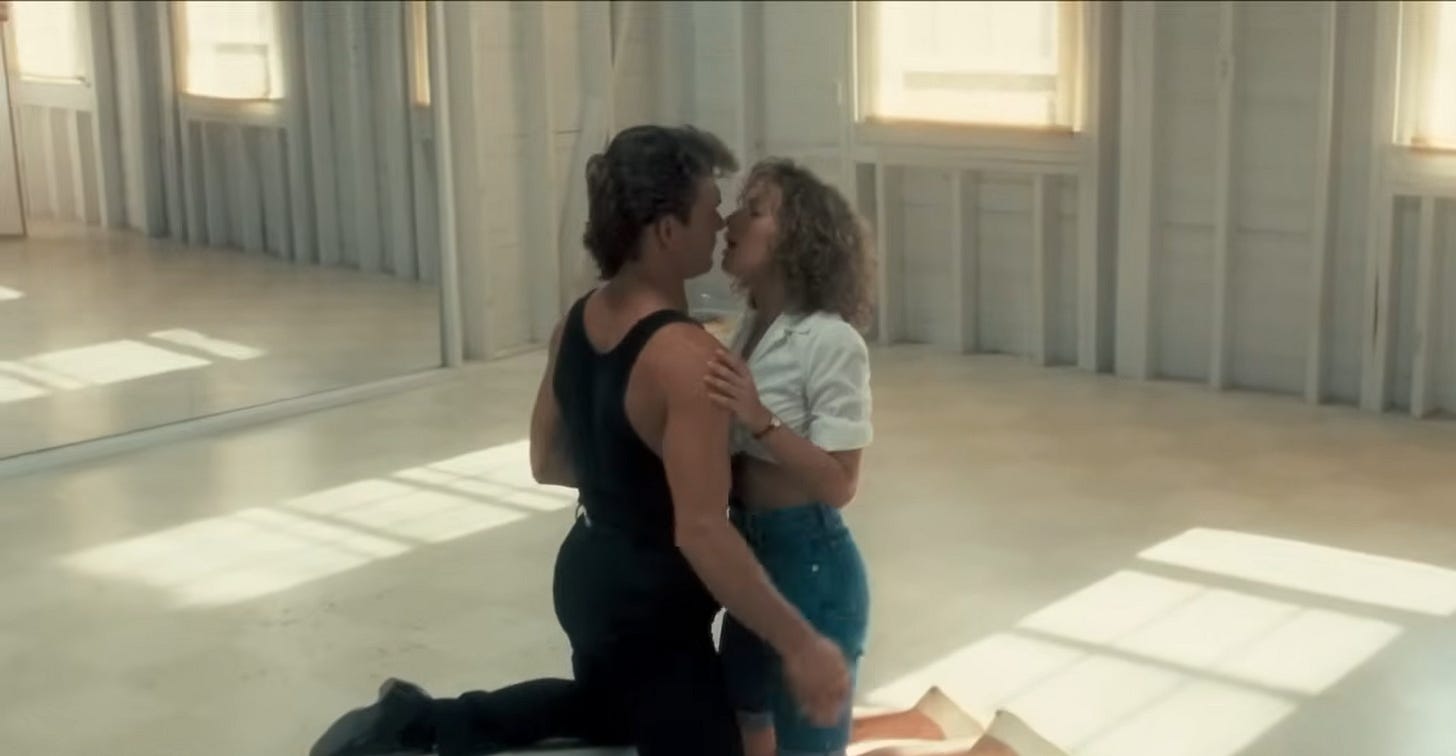Dirty Dancing (1987) & Using Height
Don't cry because it's over, cry because you had the time of your life
Friends and guests of Kellerman’s, this post contains downright dirty spoilers for Dirty Dancing.
The Film
It’s 1963 (but also the 80s, but also the 60s) and Baby - not her real name obviously - joins her family for their trip to Kellerman’s resort in the Catskills. Unexpectedly, in a sea full of smarmy future rich guys, Baby meets bad boy dance teacher, aloof, from the-wrong-side-of-the-tracks, Johnny.
I mean this respectfully but, out of spite, Baby takes the place of Johnny’s dance partner Penny, who’s in need of an abortion, to train for their big show at another resort. Despite his leather jacket, it turns out that Johnny isn’t just hot, but is also??? Nice?! They go from enemies to lovers in a film about class, feminism and creating bisexual awakenings in audience members.
If you haven’t seen Dirty Dancing, I’m so sorry, but please fix up.
Dirty Dancing is directed by Emile Ardolino and written by Eleanor Bergstein.
The Scene
By this point in the film, Baby and Johnny are fully into each other and getting along swimmingly. They’ve done their big performance and done the do, but there’s still plenty of story left. It’s also important to know that, by the time we get here, Baby has revealed to Johnny and the audience that her real name is Frances.
Watch the scene below, it’s one of many iconic moments set to equally iconic music.
The Analysis
In this short clip there’s such a wonderful in sync-ness that’s worth calling attention to! If you’ve read my Challengers analysis, you’ll see some common themes come up - there’s a lot to take from here about movement as language.
In this scene, Baby repeats instructions she’s heard from Johnny, “spaghetti arms,” “tension please,” “this my dance space,” but this time it’s playful flirting. Not only are they flirting, but his body leans towards her - into her - rather than away from her. Let’s look at the way height and levels are used as they lip-sync to Mickey & Sylvia’s ‘Love is Strange’.
As Baby teases Johnny and he moves into her, lowering himself, she pulls him up to meet her. It’s a power move, which is 1) Hot, and 2) Telling of where they’re at. This, along with the seamless and spirited lip-syncing, tells us that Baby is no longer… a baby. She’s a woman now, capable of bossing Johnny around, and he’s more than happy oblige. He’s so happy that he “collapses” to the ground.
This is the lowest he could be. He could not be more on the ground if he tried. But he’s not alone down there for long.
Baby joins him. Yes, she’s more powerful now, but she’s not seeking to make Johnny feel any less than her. They’re equals. He chooses to bring himself lower and lower because he wants to.
And even then, she brings him right back up to meet her eyes. That’s #RelationshipGoals.
In this scene, Johnny chooses not to tower over Baby, and Baby chooses to not let him lower himself for too long. There is a new understanding between them - he’s no longer just the instructor, it’s (allegedly) a level playing field (although, class will soon change things).
At the end of the scene, when Neil enters the room, they seamlessly separate, distanced from each other, horizontally and vertically.
The height difference in your characters and casting does not have to limit you, but can be used as an advantage. We should always be thinking about how we use space - not just wall to wall, but floor to ceiling.
The Exercise
Take two characters in an existing scene - they could be the same height, it really doesn’t matter! But, in whatever next scene you’re writing, consider 1) the room that they’re in, and 2) the power balance (or imbalance) between them.
At this point in the story, is one person more powerful than the other? What’s the nature of the relationship and how has it changed?
First, using the same dialogue and the same context, put them at the same level in a room. Perhaps they’re sitting down or laying in bed. Then, move one or both of them - does one stand? Does one move closer to the other? Does the other pull away?
Try a few different movements and versions, moving them closer, changing levels, pulling them apart, etcetera. Then, ask yourself: What does this add to the existing dialogue? And what’s being said through the use of space and levels?
Okay, time to Script On.
Off Script
On This Watch I Noticed…
That in the the ‘Time of My Life’ dance scene, the camera cuts back, two or three times, to this girl who’s just screaming wildly, but the sound of the scream doesn’t match her expression and I think that’s cinema.
The Award for Best Prop Goes to…
When Robbie lectures Baby on the worth of people (gross) he hands her the book, Fountainhead by Ayn Rand. Big arsehole behaviour (and not in a good way (sorry)).
If You Like…
Bisexual Awakening Cinema PLUS Narratives Where Underestimated Women Save Everyone
Disney’s Mulan (1998), obviously. How long has it been since you thought about watching it? Too long! But when was the last time you daydreamed about being saved by both Mulan and Shang? Not a day has passed, I’m sure.
A Moment of Fantastic Lip-Syncing
Man, it’s gotta be Wayne’s World. I didn’t grow up with SNL, but any time this film came on late night British TV, I was there. Is it fair to say that this introduced me to a lot of white culture? Because it did.
Great Soundtracks Where the Film Is Sort of 80s, But Also Not
Stand By Me’s soundtrack is so, so good. Plus, it was made in the 80s and set in the late 50s, but there’s also a bit of 80s in there. But also not.
Thank you for reading Script On! The next scene analysis will be on Chef (2014)!
Looking to learn screenwriting? I’m starting a workshop in London, click here to learn more!
Wanna get down and dirty with more film analysis? Weird, but okay! Subscribe for more!









